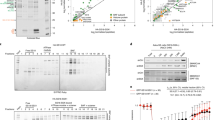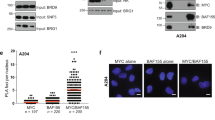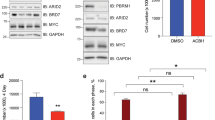Abstract
Many studies have now established that the SWI/SNF chromatin remodelling complexes are involved in activation and repression of a variety of genes. In mammalian cells, these complexes contain the BRM and BRG1 helicase-like proteins that are thought to be responsible for nucleosome remodelling. The proto-oncoprotein SYT, involved in the unique translocation t(X;18) found in synovial sarcoma, is known to interact with human BRM (hBRM), thus providing a link between chromatin remodelling factors and human cancer. In this work, we address how SYT interacts with hBRM and BRG1. We demonstrate that the conserved N-terminal SNH domain of SYT, which is also present in the oncoproteins SYT-SSX, binds to both hBRM and BRG1. We have also found that in vivo the C-terminus transactivation QPGY region of SYT can interact with itself. This results in an amplified interaction with hBRM and highlights a possible regulatory function of this domain in cells.
This is a preview of subscription content, access via your institution
Access options
Subscribe to this journal
Receive 50 print issues and online access
$259.00 per year
only $5.18 per issue
Buy this article
- Purchase on Springer Link
- Instant access to full article PDF
Prices may be subject to local taxes which are calculated during checkout







Similar content being viewed by others

References
Armstrong JA, Bieker JJ and Emerson BM . (1998). Cell, 95, 93–104.
Brett D, Whitehouse S, Antonson P, Shipley J, Cooper C and Goodwin G . (1997). Hum. Mol. Genet., 6, 1559–1564.
Clark J, Rocques PJ, Crew AJ, Gill S, Shipley J, Chan AM, Gusterson BA and Cooper CS . (1994). Nat. Genet., 7, 502–508.
Combet C, Blanchet C, Geourjon C and Deleage G . (2000). TIBS, 25, 147–150.
Crew AJ, Clark J, Fisher C, Gill S, Grimer R, Chand A, Shipley J, Gusterson BA and Cooper CS . (1995). EMBO J. 14, 2333–2340.
Dallas PB, Cheney IW, Liao DW, Bowrin V, Byam W, Pacchione S, Kobayashi R, Yaciuk P and Moran E . (1998). Mol. Cell. Biol., 18, 3596–3603.
Dallas PB, Pacchione S, Wilsker D, Bowrin V, Kobayashi R and Moran E . (2000). Mol. Cell. Biol., 20, 3137–3146.
de Bruijn DR, Baats E, Zechner U, de Leeuw B, Balemans M, Olde Weghuis D, Hirning-Folz U and Geurts van Kessel AG . (1996). Oncogene, 13, 643–648.
de Bruijn DR, dos Santos NR, Thijssen J, Balemans M, Debernardi S, Linder B, Young BD and Geurts van Kessel A . (2001). Oncogene, 20, 3281–3289.
de Leeuw B, Balemans M, Olde Weghuis D and Geurts van Kessel A . (1995). Hum. Mol. Genet., 4, 1097–1099.
Delattre O, Zucman J, Plougastel B, Desmaze C, Melot T, Peter M, Kovar H, Joubert I, de Jong P, Rouleau G, Aurias A and Thomas G (1992). Nature, 359, 162–165.
dos Santos NR, de Bruijn DR, Kater-Baats E, Otte AP and van Kessel AG . (2000). Exp. Cell Res., 256, 192–202.
dos Santos NR, de Bruijn DR and van Kessel AG . (2001). Genes Chromosomes Cancer, 30, 1–14.
Eid JE, Kung AL, Scully R and Livingston DM . (2000). Cell, 102, 839–848.
Fisher C . (1998). Ann. Diagn. Pathol., 2, 401–421.
Gure AO, Tureci O, Sahin U, Tsang S, Scanlan MJ, Jager E, Knuth A, Pfreundschuh M, Old LJ and Chen YT . (1997). Int. J. Cancer, 72, 965–971.
Hurlstone AF, Olave IA, Barker N, van Noort M and Clevers H . (2002). Biochem. J., 364, 255–264.
Kato H, Tjernberg A, Zhang W, Krutchinsky AN, An W, Takeuchi T, Ohtsuki Y, Sugano S, de Bruijn DR, Chait BT and Roeder RG . (2002). J. Biol. Chem., 277, 5498–5505.
Koch CA, Anderson D, Moran MF, Ellis C and Pawson T . (1991). Science, 252, 668–674.
Kwon H, Imbalzano AN, Khavari PA, Kingston RE and Green MR . (1994). Nature, 370, 477–481.
Lim FL, Soulez M, Koczan D, Thiesen HJ and Knight JC . (1998). Oncogene, 17, 2013–2018.
Martens JA and Winston F . (2002). Genes Dev., 16, 2231–2236.
Mason CS, Springer CJ, Cooper RG, Superti-Furga G, Marshall CJ and Marais R . (1999). EMBO J., 18, 2137–2148.
Muchardt C and Yaniv M . (2001). Oncogene, 20, 3067–3075.
Nagai M, Tanaka S, Tsuda M, Endo S, Kato H, Sonobe H, Minami A, Hiraga H, Nishihara H, Sawa H and Nagashima K . (2001). Proc. Natl. Acad. Sci. USA, 98, 3843–3848.
Nie Z, Xue Y, Yang D, Zhou S, Deroo BJ, Archer TK and Wang W . (2000). Mol. Cell. Biol., 20, 8879–8888.
Ohno T, Rao VN and Reddy ES . (1993). Cancer Res., 53, 5859–5863.
O'Neill D, Yang J, Erdjument-Bromage H, Bornschlegel K, Tempst P and Bank A . (1999). Proc. Natl. Acad. Sci. USA, 96, 349–354.
Pawson T and Gish GD . (1992). Cell, 71, 359–362.
Peterson CL . (1996). Curr. Opin. Genet. Dev., 6, 171–175.
Skytting B, Nilsson G, Brodin B, Xie Y, Lundeberg J, Uhlen M and Larsson O . (1999). J. Natl. Cancer Inst., 91, 974–975.
Smith S, Reeves BR, Wong L and Fisher C . (1987). Cancer Genet. Cytogenet., 26, 179–180.
Soulez M, Saurin AJ, Freemont PS and Knight JC . (1999). Oncogene, 18, 2739–2746.
Sudarsanam P and Winston F . (2000). Trends Genet., 16, 345–351.
Thaete C, Brett D, Monaghan P, Whitehouse S, Rennie G, Rayner E, Cooper CS and Goodwin G . (1999). Hum. Mol. Genet., 8, 585–591.
Treich I, Cairns BR, de los Santos T, Brewster E and Carlson M . (1995). Mol. Cell. Biol., 15, 4240–4248.
Tureci O, Sahin U, Schobert I, Koslowski M, Scmitt H, Schild HJ, Stenner F, Seitz G, Rammensee HG and Pfreundschuh M . (1996). Cancer Res., 56, 4766–4772.
Wang W, Cote J, Xue Y, Zhou S, Khavari PA, Biggar SR, Muchardt C, Kalpana GV, Goff SP, Yaniv M, Workman JL and Crabtree GR . (1996a). EMBO J., 15, 5370–5382.
Wang W, Xue Y, Zhou S, Kuo A, Cairns BR and Crabtree GR . (1996b). Genes Dev., 10, 2117–2130.
Xie Y, Skytting B, Nilsson G, Gasbarri A, Haslam K, Bartolazzi A, Brodin B, Mandahl N and Larsson O . (2002a). Cancer Res., 62, 3861–3867.
Xie Y, Skytting B, Nilsson G, Grimer RJ, Mangham CD, Fisher C, Shipley J, Bjerkehagen B, Myklebost O and Larsson O . (2002b). Oncogene, 21, 5791–5796.
Acknowledgements
We would like to thank Nina Perusinghe for the technical assistance with confocal microscopy. This work was supported by the Cancer Research UK and the Association of International Cancer Research.
Author information
Authors and Affiliations
Corresponding author
Rights and permissions
About this article
Cite this article
Perani, M., Ingram, C., Cooper, C. et al. Conserved SNH domain of the proto-oncoprotein SYT interacts with components of the human chromatin remodelling complexes, while the QPGY repeat domain forms homo-oligomers. Oncogene 22, 8156–8167 (2003). https://doi.org/10.1038/sj.onc.1207031
Received:
Revised:
Accepted:
Published:
Issue Date:
DOI: https://doi.org/10.1038/sj.onc.1207031
Keywords
This article is cited by
-
Whole-genome identification and expression profiling of growth-regulating factor (GRF) and GRF-interacting factor (GIF) gene families in Panax ginseng
BMC Genomics (2023)
-
Phase transition and remodeling complex assembly are important for SS18-SSX oncogenic activity in synovial sarcomas
Nature Communications (2022)
-
The epigenomics of sarcoma
Nature Reviews Cancer (2020)
-
Synovial Sarcoma: A Complex Disease with Multifaceted Signaling and Epigenetic Landscapes
Current Oncology Reports (2020)
-
Genome-Wide Identification and Analysis of the Growth-Regulating Factor (GRF) Gene Family and GRF-Interacting Factor Family in Triticum aestivum L.
Biochemical Genetics (2020)


